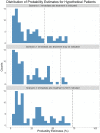Gist Representations and Decision-Making Processes Affecting Antibiotic Prescribing for Children with Acute Otitis Media
- PMID: 35911174
- PMCID: PMC9335473
- DOI: 10.1177/23814683221115416
Gist Representations and Decision-Making Processes Affecting Antibiotic Prescribing for Children with Acute Otitis Media
Abstract
Objective. To test the predictions of fuzzy-trace theory regarding pediatric clinicians' decision-making processes and risk perceptions about antibiotics for children with acute otitis media (AOM). Methods. We conducted an online survey experiment administered to a sample of 260 pediatric clinicians. We measured their risk perceptions and prescribing decisions across 3 hypothetical AOM treatment scenarios. Participants were asked to choose among the following options: prescribe antibiotics immediately, watchful waiting ("hedging"), or not prescribing antibiotics. Results. We identified 4 gists based on prior literature: 1) "why not take a risk?" 2) "antibiotics might not help but can hurt," 3) "antibiotics do not have harmful side effects," and 4) "antibiotics might have harmful side effects." All 4 gists predicted risky choice (P < 0.001), and gist endorsements varied significantly between scenarios when antibiotics were indicated, F(2, 255) = 8.53, P < 0.001; F(2, 255) = 5.14, P < .01; and F(2, 255) = 3.56, P < 0.05 for the first 3 factors, respectively. In a logistic regression, more experienced clinicians were less likely to hedge (B = -0.05; P < 0.01). Conclusion. As predicted by fuzzy-trace theory, pediatric clinicians' prescription decisions are associated with gist representations, which are distinct from verbatim risk estimates. Implications. Antibiotic stewardship programs can benefit by communicating the appropriate gists to clinicians who prescribe antibiotics for pediatric patients.
Highlights: We found clinicians' antibiotic prescription decisions were driven by gist representations of antibiotic risks for a given hypothetical patient scenario, and clinicians' gist representations and verbatim risk estimates about antibiotic-related risks were distinct from each other.We showed that the effect of patient scenarios on clinicians' antibiotic prescription decisions was mediated by clinicians' gist representations.Less experienced clinicians tend to "hedge" in their antibiotic prescription decisions compared with more experienced clinicians.The broader impact of our study is that antibiotic stewardship programs can benefit by communicating the appropriate gists to clinicians who prescribe antibiotics for pediatric patients, rather than solely focusing on closing potential knowledge deficits of the clinicians.
Keywords: antibiotic stewardship; antibiotics; fuzzy-trace theory; medical decision making; medical expertise; risk perceptions.
© The Author(s) 2022.
Conflict of interest statement
The authors declared no potential conflicts of interest with respect to the research, authorship, and/or publication of this article. The authors disclosed receipt of the following financial support for the research, authorship, and/or publication of this article: This study was funded by the GW School of Engineering and Applied Science.
Figures







Similar articles
-
Patients' and Clinicians' Perceptions of Antibiotic Prescribing for Upper Respiratory Infections in the Acute Care Setting.Med Decis Making. 2018 Jul;38(5):547-561. doi: 10.1177/0272989X18770664. Med Decis Making. 2018. PMID: 29847253 Free PMC article.
-
Categorical Risk Perception Drives Variability in Antibiotic Prescribing in the Emergency Department: A Mixed Methods Observational Study.J Gen Intern Med. 2017 Oct;32(10):1083-1089. doi: 10.1007/s11606-017-4099-6. Epub 2017 Jun 20. J Gen Intern Med. 2017. PMID: 28634909 Free PMC article.
-
Understanding decisions about antibiotic prescribing in ICU: an application of the Necessity Concerns Framework.BMJ Qual Saf. 2022 Mar;31(3):199-210. doi: 10.1136/bmjqs-2020-012479. Epub 2021 Jun 7. BMJ Qual Saf. 2022. PMID: 34099497 Free PMC article.
-
Fuzzy-trace theory: dual processes in memory, reasoning, and cognitive neuroscience.Adv Child Dev Behav. 2001;28:41-100. doi: 10.1016/s0065-2407(02)80062-3. Adv Child Dev Behav. 2001. PMID: 11605365 Review.
-
Using fuzzy-trace theory to understand and improve health judgments, decisions, and behaviors: A literature review.Health Psychol. 2016 Aug;35(8):781-792. doi: 10.1037/hea0000384. Health Psychol. 2016. PMID: 27505197 Free PMC article. Review.
Cited by
-
Barriers in implementing antibiotic stewardship programmes at paediatric units in academic hospitals in Thailand: a qualitative study.BMJ Open. 2025 May 23;15(5):e092509. doi: 10.1136/bmjopen-2024-092509. BMJ Open. 2025. PMID: 40409972 Free PMC article.
-
Factors Influencing Inappropriate Use of Antibiotics in Infants under 3 Years of Age in Primary Care: A Qualitative Study of the Paediatricians' Perceptions.Antibiotics (Basel). 2023 Apr 7;12(4):727. doi: 10.3390/antibiotics12040727. Antibiotics (Basel). 2023. PMID: 37107089 Free PMC article.
References
-
- Gerber JS, Jackson MA, Tamma PD, et al.. Antibiotic stewardship in pediatrics. Pediatrics. 2021;147(1):e2020040295. - PubMed
-
- Tribble AC, Lee BR, Flett KB, et al.. Appropriateness of antibiotic prescribing in united states children’s hospitals: a national point prevalence survey. Clin Infect Dis. 2020;71(8):e226–34. - PubMed
-
- Hamdy RF, Katz SE. The key to antibiotic stewardship is combining interventions. Pediatrics. 2020;146(3):e2020012922. - PubMed
-
- Akkerman AE, Kuyvenhoven MM, van der Wouden JC, Verheij TJ. Analysis of under- and overprescribing of antibiotics in acute otitis media in general practice. J Antimicrob Chemother. 2005;56(3):569–74. - PubMed
LinkOut - more resources
Full Text Sources
Research Materials
Miscellaneous

